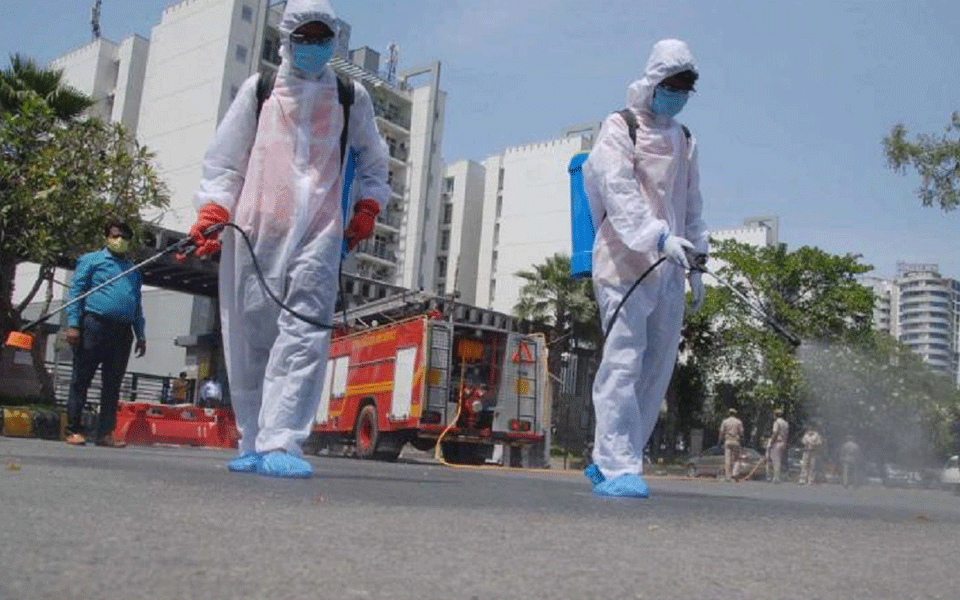New Delhi: In addition to measures like social distancing and wearing masks, an Indian-German team of scientists recommend controlling indoor humidity conditions to contain the spread of the novel coronavirus which causes COVID-19.
The researchers, including those from CSIR National Physical Laboratory in New Delhi, said in order to contain the pandemic, it is extremely important to implement standards for indoor air humidity in rooms with many people, such as hospitals, open-plan offices, or public transport.
In their review of studies, published in the journal Aerosol and Air Quality Research, the scientists specifically drew focus on relative humidity, which is a measure of water vapour in the air compared to the total saturation of vapour that can exist in the air at its current temperature.
According to the study, a relative humidity of 40 to 60 percent could reduce the spread of viruses and their absorption through the nasal mucous membrane.
The scientists said tiny drops of five micrometres in diameter, such as those produced when speaking, can float in the air for up to nine minutes.
"In aerosol research, it has long been known that air humidity plays a major role -- The more humid the air is, the more water adheres to the particles and so they can grow faster. So, we were curious -- what studies have already been conducted on this," explained Ajit Ahlawat, a co-author of the study from the Leibniz Institute for Tropospheric Research (TROPOS) in Germany.
According to the scientists, humidity affects the behaviour of microorganisms within the virus droplets, and the survival or inactivation of the virus on the surfaces.
They said it also influences the role of dry indoor air in the airborne transmission of viruses.
"If the relative humidity of indoor air is below 40 per cent, the particles emitted by infected people absorb less water, remain lighter, fly further through the room and are more likely to be inhaled by healthy people," Ahlawat explained.
"In addition, dry air also makes the mucous membranes in our noses dry and more permeable to viruses," he said.
The scientists believe the new findings are particularly important for the upcoming winter season in the northern hemisphere, when millions of people will be staying in heated rooms.
"Heating the fresh air also ensures that it dries. In cold and temperate climate zones, therefore, the indoor climate is usually very dry during the heating season. This could encourage the spread of coronaviruses," said study co-author Alfred Wiedensohler of TROPOS.
At a higher humidity, the scientists said droplets grow faster, fall to the ground earlier, and can be inhaled less by healthy people.
"A humidity level of at least 40 per cent in public buildings and local transport would therefore not only reduce the effects of COVID-19, but also of other viral diseases such as seasonal flu. Authorities should include the humidity factor in future indoor guidelines," added study co-author Sumit Kumar Mishra of CSIR - National Physical Laboratory in New Delhi.
For countries in cool climates, the scientists recommend a minimum indoor humidity.
They said countries in tropical and hot climates, on the other hand, should take care that indoor rooms are not extremely undercooled by air conditioning systems.
When air is extremely cooled, it dries out the air and the particles in it, making people inside the room feel comfortable, but the dry particles will remain in the air for longer duration, the researchers warned.
They added that the measures already known, such as social distancing, having as few people per room as possible, and wearing masks should also be practised to lower the risk of infection.
Let the Truth be known. If you read VB and like VB, please be a VB Supporter and Help us deliver the Truth to one and all.
Amritsar (PTI): Former president Ram Nath Kovind on Friday said that with digital transformation, economic reforms and a strong focus on the ease of doing business, India is moving towards becoming a global economic powerhouse.
He was speaking after inaugurating the 19th edition of the Punjab International Trade Expo (PITEX) in Amritsar.
The former president said that this 19th edition of PITEX is being organised at a time when India is recognised as one of the fastest-growing large economies in the world.
Speaking at the inaugural ceremony of the event organised by the PHD Chamber of Commerce and Industry (PHDCCI) the former president, while referring to Punjab, said the state is a living example of courage, sacrifice and enterprise.
"The spiritual light of Sri Harmandir Sahib (Golden Temple) inspires peace and humanity across the world. The heritage of Punjab is deep and inspiring," Kovind said, according to a statement issued by the PITEX.
The former president congratulated the PHDCCI for hosting the 19th edition of PITEX and suggested that the chamber should expand PITEX outside Punjab.
He proposed that a similar event should also be held in New Delhi.


_vb_69.jpeg)


